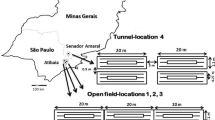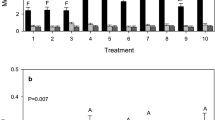Abstract
Effects of crop rotation between rice paddy fields and strawberry nurseries on the control of Verticillium wilt of strawberry were studied. For detecting Verticillium dahliae, the causal agent of Verticillium wilt, in soil, eggplant was used as an indicator plant. We were thus able to detect as low as 1 microsclerotium/g dry soil. In field surveys of Chiba and Hokkaido from 2000 to 2003, V. dahliae was detected in 9 of 10 upland fields but in none of 21 paddy-upland fields. In Hokkaido during 2000–2007, strawberry mother plants were planted, and plantlets were produced in upland and paddy-upland fields to assess V. dahliae infestation. Verticillium wilt of strawberry had never occurred in 72 tested paddy-upland fields, compared to 13.2–73.9% of plantlets infected with V. dahliae in upland fields. In a pot experiment in a greenhouse, two flooding treatments or two paddy rice cultivations suppressed Verticillium wilt symptoms on eggplant. In field experiments, one paddy rice cultivation in Chiba and two in Hokkaido prevented development of Verticillium wilt symptoms on eggplant. Verticillium wilt of strawberry was controlled completely with one paddy rice cultivation in infested fields in Chiba. In these field experiments, the number of microsclerotia of V. dahliae decreased under the flooding conditions for paddy rice cultivation. Based on the reduction in microsclerotia, a crop rotation system with paddy rice for 3 years (three times), green manure for 1 year, and strawberry nursery for 1 year was designed for Hokkaido.





Similar content being viewed by others
References
Berg G, Kurze S, Buchner A, Wellington EM, Smalla K (2000) Successful strategy for the selection of new strawberry-associated Rhizobacteria antagonistic to Verticillium wilt. Can J Microbiol 46:1128–1137
Ebihara Y, Nagao H, Uematsu S, Moriwaki J, Kimishima E (2003) First report of Verticillium tricorpus isolated from potato tubers in Japan. Mycoscience 44:481–488
Govorova GF (1997) Phytopathological aspects of strawberry breeding for resistance to Verticillium wilt. Acta Hortic 439:195–197
Harris DC (1989) Control of Verticillium wilt of strawberry in Britain by chemical soil disinfestation. J Hortic Sci 64:683–686
Harris DC, Yang JR (1996) The relationship between the amount of Verticillium dahliae in soil and the incidence of strawberry wilt as a basis for disease risk prediction. Plant Pathol 45:106–114
Hashimoto K (1983) Verticillium wilt of eggplant and its control (in Japanese). Plant Prot 37:111–116
Hashimoto K (1989) Studies on Verticillium wilt of eggplant (in Japanese with English summary). Bull Saitama Hortic Exp Stn 2:1–110
Hawksworth DL, Talboys PW (1970) Verticillium dahliae. In: CMI descriptions of pathogenic fungi and bacteria, No. 256. Commonwealth Mycological Institute, Ferry Lane, UK
Horiuchi S, Hagiwara H, Takeuchi S (1990) Host specificity of isolates of Verticillium dahliae towards cruciferous and solanaceous plants. In: Hornby D (ed) Biological control of soil-borne plant pathogens. CAB International, Wallingford, UK, pp 285–298
Horiuchi S, Sato M, Yamauchi N (2000) Pathogenicity of Verticillium dahliae isolates to strawberry cultivars (in Japanese). Ann Rept Soc Pl Prot North Jpn 51:80–82
Howard CM, Albregts EE (1982) Outbreak of Verticillium wilt of strawberries in central Florida. Plant Dis 66:856–857
Iijima T (1983) Studies on Verticillium wilt of tomato (in Japanese with English summary). Bull Tokyo Agric Exp Stn 16:63–128
Iijima T, Tomita C (1982) The method to produce microsclerotia of Verticillium dahliae abundantly (Abstract in Japanese). Ann Phytopathol Soc Jpn 48:133
Jordan VWL (1971) A method of screening strawberries for resistance to Verticillium wilt. Plant Pathol 20:167–170
Kitani K, Kuniyasu K, Natsume T (1968) Studies on the southern blight, Corticium rolfsii (Saccardo) CURZI, of ladino clover, Trifolium repens L. cultivated in paddy fields of upland condition (in Japanese with English summary). Bull Shikoku Agric Exp Stn 18:139–160
Komada H, Takeuchi S, Fujii H, Inoue Y (1970) Survival of several root-infecting pathogens of vegetable crops in paddy soil (in Japanese with English summary). Bull Tokai-Kinki Natl Agric Exp Stn 20:151–166
Konagai K, Sakamoto K, Usami T, Amemiya Y, Shishido M (2005) Effect of wild oats green manure on soil microflora and diseases of tomato (in Japanese with English summary). Jpn J Phytopathol 71:101–110
Kurze S, Bahl H, Dahl R, Berg G (2001) Biological control of fungal strawberry diseases by Serratia plymuthica HRO-C48. Plant Dis 85:529–534
Matsuda A, Ozaki K, Shimonagane K (1979) On the population of Fusarium oxysporum in paddy field soils in Ibaraki Prefecture and the alternation of soil fungistasis in paddy field converted to upland condition (in Japanese). Bull Ibaraki Agric Exp Stn 20:17–30
Murata J, Ohara K (1938) Studies on Fusarium wilt of watermelon (10) (in Japanese). Byochugai Zasshi 19:491–498
Nakagawa A, Nakamura Y, Suga Y, Mukaida Y (2006) Effect of flooding on the incidence of potato common scab (in Japanese). Proc Kanto-Tosan Pl Prot Soc 53:23–28
Niidome I, Itoga S (1960) The survival of Rhizoctonia solani under flooding condition (in Japanese). Proc Assoc Pl Prot Kyushu 6:87–88
Nishi K, Tsukuda K, Sato T, Hagiwara H (1994) Control of root necrosis of soybean caused by Calonectria crotalariae by paddy-upland rotation (in Japanese). Proc Kanto-Tosan Pl Prot Soc 41:51–54
Okazaki H (1985) Volatile(s) from glucose-amended flooded soil influencing survival of Fusarium oxysporum f sp. raphani. Ann Phytopathol Soc Jpn 51:264–271
Pegg GF, Brady BL (2002) Verticillium wilts. CAB International, Oxford, UK
Pullman GS, DeVay JE (1981) Effect of soil flooding and paddy rice culture on the survival of Verticillium dahliae and incidence of Verticillium wilt in cotton. Phytopathology 71:1285–1289
Sakai H, Hagiwara H, Shiraishi T, Miyahara K, Takehara T, Nakayama T, Nagai K (1996) The pathgenicity of 15 isolates of Verticillium dahliae from strawberry plants in Gunma Prefecture (Abstract in Japanese). Ann Phytopathol Soc Jpn 62:606–607
Schnathorst WC, Mathre DE (1966) Host range and differentiation of a severe form of Verticillium albo-atrum in cotton. Phytopathology 56:1155–1161
Seemüller E (1998) Crown rot. In: Maas JL (ed) Compendium of strawberry diseases, 2nd edn. APS Press, St. Paul, pp 50–51
Shaw DV, Gubler WD, Hansen J (1997) Field resistance of California strawberries to Verticillium dahliae at three conidial inoculum concentrations. Hortscience 32:711–713
Shiraishi T (1988) Comparison of methods for the detection of Verticillium dahliae in soil (in Japanese). Soil Microorg 31:67–69
Shiraishi T, Sunaga F (1993) A study of soil inoculation method by microsclerotia of Verticillium dahliae, the pathogen of Verticillium wilt of udo (Aralia cordata Thumb.) (Abstract in Japanese). Ann Phytopathol Soc Jpn 59:732–733
Sonku Y (1978a) Practical side of soil-borne disease control using water (1) (in Japanese). Agric Hortic 53:1255–1259
Sonku Y (1978b) Practical side of soil-borne disease control using water (2) (in Japanese). Agric Hortic 53:1373–1378
Sonku Y, Kita K (1979) Studies on violet root rot of sweet potato (in Japanese). Proc Assoc Pl Prot Kyushu 25:21–24
Sonoda T, Kaji K (1992) Pathogenic strains of Verticillium dahliae, causal agent of Verticillium wilt of strawberry, and pathogenicity of Verticillium dahliae strains (in Japanese). Ann Rept Soc Pl Prot North Jpn 43:77–79
Steffek R, Spornberger A, Altenburger J (2006) Detection of microsclerotia of Verticillium daliae in soil samples and prospects to reduce the inoculum potential of the fungus in the soil. Agric Conspec Sci 71:145–148
Stover RH (1955) Flood-fallowing for eradication of Fusarium oxysporum f. sp. cubense: III. Effect of oxygen on fungus survival. Soil Sci 80:397–412
Sumino A (1995) The present situation on research of Verticillium wilt of potato in Hokkaido (in Japanese). Plant Protect 49:500–505
Sumino A (1998a) Microsclerotial density of Verticillium dahliae in potato field soils in Hokkaido (Abstract in Japanese). Ann Phytopathol Soc Jpn 64:331
Sumino A (1998b) Modification of selective medium for detection of Verticillium dahliae from soil (Abstract in Japanese). Ann Phytopathol Soc Jpn 64:581
Suzui T, Kibushi H, Iwakura K, Kobayashi Y, Makino T (1984) Occurrence of Verticillium wilt of strawberry and its control in Shizuoka Prefecture (in Japanese). Proc Kanto-Tosan Pl Prot Soc 31:52–53
Suzuki T, Muramatsu Y, Ikegaya Y, Morita H, Nakamura H, Hori K, Saigo S, Kurita H, Kamiya E (1979) Control of wilting symptom of tomato plants grown semi-forcingly: VII. Control of corky-root disease of tomato by crop rotation (in Japanese with English summary). Bull Shizuoka Agric Exp Stn 24:23–32
Tairako K, Kaji K, Sonoda T (1993) Runners transmission of Verticillium wilt of strawberry (Abstract in Japanese). Ann Phytopathol Soc Jpn 59:759
Takahashi H (2000) Relay production of strawberry plantlet. In: Matsuda T (ed) Advanced efforts of strawberry culture and management. Japan Agricultural Development and Extension Association, Tokyo, Japan, pp 191–195
Takahashi H, Shibusawa U, Iida K (1954) Studies on the periodical alternation of lowland and upland field: (I). The growth and yield of crops in the upland field period (in Japanese with English summary). J Kanto-Tosan Agric Exp Stn 6:1–37
Tamura O, Hagiwara H, Takeuchi S (1985) The investigation of detection method from soil and selective medium of Verticillium dahliae (Abstract in Japanese). Ann Phytopathol Soc Jpn 51:111
Tanaka Y, Kusakari S (1987) Effects of soil flooding and millet culture on Verticillium wilt of eggplant (in Japanese with English summary). Bull Osaka Agric Res Cent 24:37–41
Tanaka Y, Nieda H, Noda N, Yamanaka M, Honda N (1979) Studies on ecology and control of the bacterial wilt disease of tobacco caused by Pseudomonas solanacearum: V. Control of the bacterial wilt disease of tobacco by flooding (in Japanese with English summary). Bull Utsunomiya Tobacco Exp Stn 1:57–64
Tezuka T, Takahashi S, Iwaki H, Hongo T, Hoshino M (1974) Occurrence of Fusarium wilt, Verticillium wilt and red stele of strawberry in Tochigi Prefecture (in Japanese). Proc Kanto-Tosan Pl Prot Soc 21:46–47
Tominaga T, Sugimoto T, Takahashi S (1966) First report of Rhizoctonia web blight of strawberry (in Japanese). Plant Protect 20:168–172
Torikura H (ed) (1999) Control of Verticillium wilt and Fusarium wilt of strawberry. In: 90th anniversary issue of Hokkaido Dohnan Agricultural Experiment Station. Hokkaido Dohnan Agricultural Experiment Station, Hokuto, Hokkaido, Japan
Uchida T, Asari S, Ashizawa T (1981) Control of tomato Verticillium wilt by rotation with paddy field (in Japanese). Proc Kanto-Tosan Pl Prot Soc 28:48
Wilhelm S, Paulus AO (1980) How soil fumigation benefits the California strawberry industry. Plant Dis 64:264–270
Wilhelm S, Storkan RC, Sagen JE (1961) Verticillium wilt of strawberry controlled by fumigation of soil with chloropicrin and chloropicrin–methyl bromide mixtures. Phytopathology 51:744–748
Yoshino M (1966) Verticillium wilt of strawberry caused by Verticillium sp. (in Japanese). Plant Protect 20:489–492
Acknowledgments
We thank the members of Awa Prefectural Agriculture Extension Center (H. Someya and S. Miyahara) and Hokkaido Prefectural Agriculture Extension Center (E. Kawamura, I. Matsumoto and Y. Narimatsu) for help with fieldwork and for useful advice. We also appreciate the members of Gunma Agricultural Technology Center (T. Shiraishi and H. Sakai), Chiba University (Dr. M. Shishido and Dr. T. Usami), Chiba Prefectural Agriculture Research Center (M. Kanda and T. Otani), A. Shinmura (Hokkaido Prefectural Dohnan Agricultural Experiment Station), and A. Sumino (Hokkaido Central Agricultural Experiment Station) for useful advice.
Author information
Authors and Affiliations
Corresponding author
Rights and permissions
About this article
Cite this article
Ebihara, Y., Uematsu, S. & Nomiya, S. Control of Verticillium dahliae at a strawberry nursery by paddy-upland rotation. J Gen Plant Pathol 76, 7–20 (2010). https://doi.org/10.1007/s10327-009-0205-x
Received:
Accepted:
Published:
Issue Date:
DOI: https://doi.org/10.1007/s10327-009-0205-x




